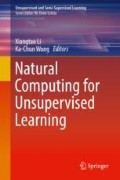Abstract
Heuristic algorithms are widely used in the diverse fields of engineering and sciences and prove its efficiency over classical algorithms. In the analysis of chemical process, it is observed that the formation of new product consists of a proficient computational procedure among chemical reactions. These chemical reactions consist of objects, events, states, and process. In this work, an efficient and robust algorithm, called artificial chemical reaction optimization algorithm, is adopted for solving the partitional clustering problems. The performance of the proposed algorithm is investigated on well-known clustering datasets. Further, the simulation results of the CRO-based clustering algorithm are compared with some state-of-the-art clustering algorithms. It is seen that proposed clustering algorithm provides better performance than other algorithms in terms of intra-cluster distance and f-measure.
Access this chapter
Tax calculation will be finalised at checkout
Purchases are for personal use only
References
Alatas B (2011) ACROA: artificial chemical reaction optimization algorithm for global optimization. Expert Syst Appl 38(10):13170–13180
Alatas B (2012) A novel chemistry based metaheuristic optimization method for mining of classification rules. Expert Syst Appl 39(12):11080–11088
Anaya AR, Boticario JG (2011) Application of machine learning techniques to analyses student interactions and improve the collaboration process. Expert Syst Appl 38(2):1171–1181
Dunn WJ III, Greenberg MJ, Callejas SS (1976) Use of cluster analysis in the development of structure-activity relations for antitumor triazenes. J Med Chem 19(11):1299–1301
Gandomi AH, Yang XS, Alavi AH, Talatahari S (2013) Bat algorithm for constrained optimization tasks. Neural Comput Applic 22(6):1239–1255
Hatamlou A (2013) Black hole: a new heuristic optimization approach for data clustering. Inform Sci 222:175–184
He Y, Pan W, Lin J (2006) Cluster analysis using multivariate normal mixture models to detect differential gene expression with microarray data. Comput Stat Data Anal 51(2):641–658
Hung YS, Chen KLB, Yang CT, Deng GF (2013) Web usage mining for analyzing elder self-care behavior patterns. Expert Syst Appl 40(2):775–783
Kaveh A, Talatahari S (2010) A novel heuristic optimization method: charged system search. Acta Mech 213(3):267–289
Kaveh A, Share MAM, Moslehi M (2013) Magnetic charged system search: a new meta-heuristic algorithm for optimization. Acta Mech 224(1):85–107
Kumar Y, Sahoo G (2014) A charged system search approach for data clustering. Prog Artif Intell 2(2-3):153–166
Kumar Y, Sahoo G (2015) Hybridization of magnetic charge system search and particle swarm optimization for efficient data clustering using neighborhood search strategy. Soft Comput 19(12):3621–3645
Kumar Y, Sahoo G (2015) A hybrid data clustering approach based on improved cat swarm optimization and K-harmonic mean algorithm. AI Commun 28(4):751–764
Kumar Y, Sahoo G (2016) A hybridize approach for data clustering based on cat swarm optimization. Int. J Inf Commun Technol 9(1):117–141
MacQueen J (1967) Some methods for classification and analysis of multivariate observations. In: Fifth Berkeley Symposium on Mathematics. Statistics and Probability. University of California Press, pp 281–297
Shah-Hosseini H (2011) Principal components analysis by the galaxy-based search algorithm: a novel metaheuristic for continuous optimisation. Int J Comput Sci Eng 6(1-2):132–140
Shelokar PS, Jayaraman VK, Kulkarni BD (2004) An ant colony approach for clustering. Analy Chim Acta 509(2):187–195
Teppola P, Mujunen SP, Minkkinen P (1999) Adaptive Fuzzy C-Means clustering in process monitoring. Chemom Intel Lab Syst 45(1):23–38
Webb A (2002) Statistical pattern recognition. Wiley, New Jersey, pp 361–406
Zhan ZH, Zhang J, LiY CSH (2009) Adaptive particle swarm optimization. IEEE Trans Syst Man Cybern B Cybern 39:1362–1381
Zhou H, Liu Y (2008) Accurate integration of multi-view range images using k-means clustering. Pattern Recognit 41(1):152–175
Author information
Authors and Affiliations
Editor information
Editors and Affiliations
Rights and permissions
Copyright information
© 2019 Springer International Publishing AG, part of Springer Nature
About this chapter
Cite this chapter
Kumar, Y., Dahiya, N., Malik, S., Yadav, G., Singh, V. (2019). Chemical Reaction-Based Optimization Algorithm for Solving Clustering Problems. In: Li, X., Wong, KC. (eds) Natural Computing for Unsupervised Learning. Unsupervised and Semi-Supervised Learning. Springer, Cham. https://doi.org/10.1007/978-3-319-98566-4_7
Download citation
DOI: https://doi.org/10.1007/978-3-319-98566-4_7
Published:
Publisher Name: Springer, Cham
Print ISBN: 978-3-319-98565-7
Online ISBN: 978-3-319-98566-4
eBook Packages: EngineeringEngineering (R0)

